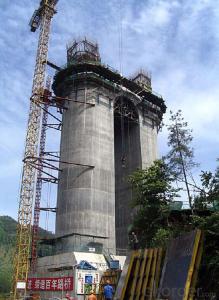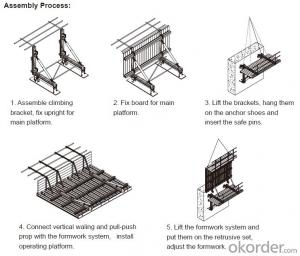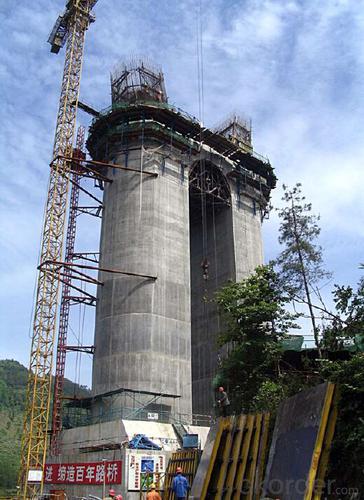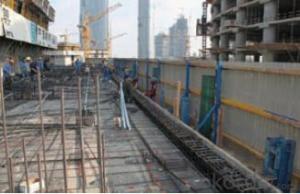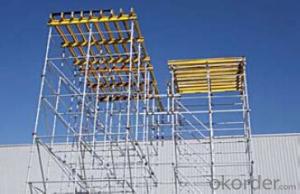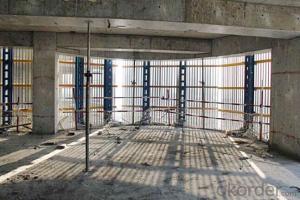Auto Climbing Bracket ACB100 & ACB50 for formwork and scaffolding system
- Loading Port:
- Tianjin
- Payment Terms:
- TT OR LC
- Min Order Qty:
- 50 m²
- Supply Capability:
- 1000 m²/month
OKorder Service Pledge
OKorder Financial Service
You Might Also Like
Auto-climbing Bracket ACB100 & ACB50
The power of the auto-climbing formwork is the hydraulic system, which includes the oil cylinder
and two commutators. The commutators can control the climbing of climbing rail and the bracket.
The steel rail and the bracket can inter-climbing, so the whole system will climb up steadily.
Cranes are not needed during the construction. It’s easy to operate, highly efficient and safe. It’s
the best choice for the construction of high buildings and bridges.
There are mainly two types of standard auto-climbing brackets, ACB-50 and ACB-100, the figure
means the push power of cylinder with unit of KN.
Characteristics:
◆ Perfect load bearing anchor system
Anchor system is the most important supporting part. The system is made of five parts shown
below. Thereinto, tensile bolt, V-climbing cone and washer can be taken out for reusing after the
concrete pouring finished.There are two kinds of anchor systems,A & B. A is matched with single
anchor shoe and B is matched with double anchor shoe.
◆ Crane-independent
Crane-independent forming, striking and climbing speeds up the work procedures on the
construction site and also makes them independent of each other. This means the planned
sequences can be maintained along with guaranteeing high productivity levels. The crane can
therefore be used for other tasks.
Hydraulic system is mainly made of two commutators,
oil cylinder and power distribution system.The
commutators can control the climbing of climbing rail
and bracket.
◆ High bearing capacity and safe
The stable working platforms are able to carry large loads, e.g. the storage of reinforcing steel
for the next climbing section. Generously-sized working platforms, the well thought-out design for
handling very high wind loads and the patented control function of the climbing mechanism are
some of the special details contained within the comprehensive safety concept.
◆ Platforms adjusted to suit the angle of inclination
The horizontal working areas thus created provide safe and comfortable conditions for
reinforcement work, shuttering and striking, concreting and finishing.
◆ The ACB formwork system can climb not only vertically but also slantways, the largest angle is
18 degrees.
◆ The system can climb up wholly or separately. The climbing process is steady, synchronous
and safe.
◆ The bracket will not fall to the ground until the construction is finished, the field will be saved
and the impacting breakage will be reduced (especially the panel).
◆ The system will furnish omnidirectional platform, the construction organizations don’t need to
set up additional operation platform.
◆ The error of structure construction is small and easy to correct.
◆ The climbing speed is fast, the construction course will be quickened.
◆ The formwork can climb itself and cleaning work can be done in the same situs , the used times
of tower crane will be greatly reduced.
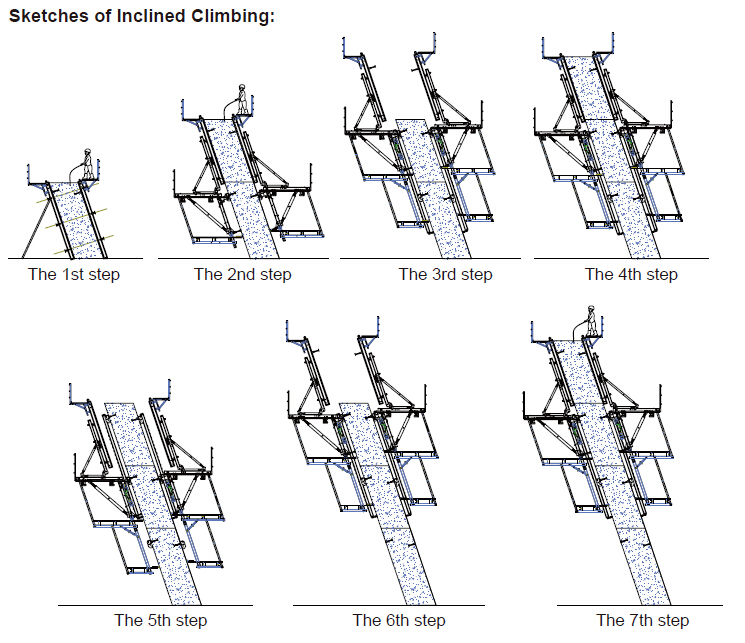
- Q: Can steel formwork be used for both residential and commercial renovations?
- Yes, steel formwork can be used for both residential and commercial renovations. Steel formwork is known for its durability and strength, making it suitable for various construction projects. Whether it is a residential renovation such as adding an extension or a commercial renovation like remodeling an office space, steel formwork can provide the necessary support and stability during the construction process. Additionally, steel formwork can be easily customized and adjusted to fit different project requirements, making it a versatile option for both residential and commercial renovations.
- Q: Are there any environmental benefits to using steel formwork?
- Yes, there are several environmental benefits to using steel formwork. Firstly, steel formwork is reusable, which reduces the need for continuous production of new formwork materials, thereby reducing the consumption of natural resources. Secondly, steel formwork is highly durable and can withstand repeated use, reducing the overall waste generated from construction projects. Lastly, steel is a recyclable material, so at the end of its life cycle, it can be recycled and used for other purposes, reducing the amount of waste sent to landfills. Overall, using steel formwork helps minimize environmental impact and promotes sustainability in construction practices.
- Q: What are the considerations when designing steel formwork for architectural sculptures?
- When designing steel formwork for architectural sculptures, there are several important considerations that need to be taken into account. Firstly, the structural integrity and stability of the formwork is paramount. The formwork must be able to withstand the weight of the concrete or other materials that will be poured into it, as well as any external forces that may be applied during the construction process. This requires careful analysis and engineering to ensure that the formwork is strong enough to support the weight and forces without any risk of collapse. Secondly, the accuracy and precision of the formwork is crucial. Architectural sculptures often require intricate and detailed designs, so the formwork must be able to accurately reproduce these shapes. This may involve using advanced computer-aided design (CAD) software to create precise 3D models of the sculpture, which can then be used to fabricate the formwork. Another consideration is the ease of assembly and disassembly of the formwork. Architectural sculptures can be complex and intricate, so the formwork must be designed in a way that allows for easy assembly and disassembly. This may involve using modular components that can be easily connected and disconnected, as well as incorporating features such as adjustable supports or brackets to accommodate different shapes and sizes. Additionally, the choice of materials for the formwork is important. Steel is a common choice due to its strength and durability, but other materials such as aluminum or fiberglass may also be used depending on the specific requirements of the project. The materials used must be able to withstand the weight and forces applied during construction, as well as any potential exposure to weather or other environmental conditions. Finally, considerations should be made for the aesthetics of the formwork. While the primary function of the formwork is to support the construction process, it is also important that it does not detract from the overall visual impact of the sculpture. This may involve using smooth finishes, hidden connections, or other design techniques to ensure that the formwork remains visually appealing. In conclusion, designing steel formwork for architectural sculptures requires careful consideration of factors such as structural integrity, accuracy, ease of assembly, material selection, and aesthetics. By addressing these considerations, designers can ensure that the formwork is not only functional and safe but also enhances the overall artistic vision of the sculpture.
- Q: What are the considerations when designing steel formwork for retaining structures?
- Several important considerations need to be taken into account when designing steel formwork for retaining structures. These considerations encompass load capacity, durability, ease of installation and removal, flexibility, safety, and cost-effectiveness. To begin with, the formwork must be designed to withstand the weight of the concrete and any additional loads, such as soil or hydrostatic pressure, without deformation or failure. It should possess sufficient strength and stability to support these loads. Furthermore, steel formwork should be designed with durability in mind, capable of enduring the harsh conditions encountered during construction, including exposure to moisture, chemicals, and temperature variations. The material used should have corrosion-resistant properties to ensure long-term durability. In terms of installation and removal, the formwork should be designed to be easily and efficiently assembled and disassembled. This can be achieved through features like modular panels or adjustable components. It should also allow for easy access during concrete pouring and curing. Flexibility is another crucial consideration, as the formwork should be adaptable to different shapes and sizes of retaining structures. This can be achieved through the use of adjustable components or adaptable formwork systems. Such flexibility enables the formwork to be utilized for multiple projects, reducing costs and improving efficiency. Safety is of utmost importance when designing steel formwork. The formwork should provide a safe working environment for construction workers, incorporating features such as anti-slip surfaces, guardrails, and proper anchoring systems. Stability and load distribution should also be considered to minimize the risk of accidents or collapse. Cost-effectiveness should be achieved by optimizing material usage, minimizing waste, and reducing labor requirements. This can be accomplished through efficient design, such as utilizing standardized components or modular systems that can be easily reused. The design should also consider ease of maintenance and repair to minimize long-term costs. In conclusion, when designing steel formwork for retaining structures, it is crucial to consider load capacity, durability, ease of installation, flexibility, safety, and cost-effectiveness. By carefully considering these factors, a well-designed formwork system can be created, ensuring the successful construction of retaining structures.
- Q: What are the considerations when designing steel formwork for underground parking structures?
- When designing steel formwork for underground parking structures, there are several important considerations that need to be taken into account. These considerations include: 1. Structural Stability: Underground parking structures experience significant loads from the surrounding soil, as well as the weight of the vehicles they will accommodate. It is crucial to design the steel formwork in a way that ensures structural stability and can withstand these loads. 2. Water Resistance: Underground parking structures are susceptible to water infiltration, especially in areas with high groundwater levels. The steel formwork should be designed to be watertight, with proper sealing and waterproofing measures in place, to prevent water damage and maintain the integrity of the structure. 3. Fire Resistance: Fire safety is of utmost importance in underground parking structures. The steel formwork should be designed to meet the required fire resistance standards and provide adequate protection against fire hazards. 4. Durability: Underground parking structures are subject to constant traffic and wear and tear. The steel formwork should be designed to be durable and able to withstand the load and stress imposed by vehicles, as well as any potential impact from collisions or accidents. 5. Accessibility and Efficiency: The design of the steel formwork should take into consideration the accessibility of the parking structure, including the layout of ramps, entrances, and exits. It should also aim to maximize space utilization and efficiency, providing adequate parking slots without compromising safety or ease of use. 6. Maintenance and Repairs: The design should also consider the ease of maintenance and repairs. Accessible areas for inspection, maintenance, and repairs should be incorporated into the formwork design to ensure that any necessary maintenance or repairs can be carried out efficiently. 7. Cost-effectiveness: Finally, the design should strike a balance between meeting all the necessary requirements and being cost-effective. It is essential to consider the overall cost of materials, construction, and maintenance when designing the steel formwork for underground parking structures. By carefully considering these considerations, engineers and designers can create effective and efficient steel formwork for underground parking structures that meet all the necessary requirements for safety, durability, and functionality.
- Q: Can steel formwork be used for both standard and non-standard concrete sections?
- Yes, steel formwork can be used for both standard and non-standard concrete sections. Steel formwork offers versatility and flexibility in shaping different types of concrete sections, allowing for the creation of various shapes and sizes. Its durability and strength make it suitable for use in both standard and non-standard concrete construction projects.
- Q: How does steel formwork differ from other types of formwork?
- Steel formwork differs from other types of formwork in several ways. Firstly, steel formwork is highly durable and can be used multiple times, whereas other types of formwork such as wood or plywood may need to be replaced after a few uses. Additionally, steel formwork provides a smooth and precise finish, resulting in high-quality concrete structures. It also offers a higher load-bearing capacity, allowing for the construction of larger and more complex structures. Moreover, steel formwork can be easily fabricated and assembled, reducing construction time and labor costs. Overall, steel formwork is a more robust, efficient, and cost-effective solution compared to other types of formwork.
- Q: Can steel formwork be used in areas with high seismic vulnerability?
- Yes, steel formwork can be used in areas with high seismic vulnerability. Steel is a strong and durable material that can withstand the forces and vibrations caused by earthquakes. It provides stability and structural integrity to the formwork system, making it suitable for use in seismic-prone regions. Additionally, steel formwork can be designed and reinforced to meet the specific requirements and regulations of the area, ensuring its suitability for use in high seismic vulnerability zones.
- Q: How does steel formwork handle high concrete pressures?
- Steel formwork is able to handle high concrete pressures due to its inherent strength and rigidity. Steel is a durable and robust material that has the ability to withstand significant loads and pressures without deforming or collapsing. It ensures that the formwork structure remains stable and secure, even when subjected to the high pressures exerted by the poured concrete. This makes steel formwork an ideal choice for construction projects where high concrete pressures are anticipated.
- Q: Are there any specific considerations for using steel formwork in seismic zones?
- Yes, there are specific considerations for using steel formwork in seismic zones. Steel formwork is known for its high strength and rigidity, which makes it suitable for withstanding seismic forces. However, it is essential to ensure that the steel formwork is designed and installed correctly to withstand the expected seismic loads. This includes using robust connections, adequate bracing, and proper reinforcement. Additionally, the formwork should be inspected regularly to identify any potential vulnerabilities or damage that could compromise its performance during an earthquake.
Send your message to us
Auto Climbing Bracket ACB100 & ACB50 for formwork and scaffolding system
- Loading Port:
- Tianjin
- Payment Terms:
- TT OR LC
- Min Order Qty:
- 50 m²
- Supply Capability:
- 1000 m²/month
OKorder Service Pledge
OKorder Financial Service
Similar products
Hot products
Hot Searches
